| S.No. |
Research work |
Photo |
|
Induced breeding and quality seed production of carps
To ensure availability of quality seeds of cultivable carps throughout the year, the induced breeding technology using crude pituitary extract, ovaprim, ovatide, Wova- FH, Gonopro- FH and Ovarim has been developed for the Tarai region of Uttarakhand. Catla, Rohu, Mrigal, Grass carp and Silver carp are being successfully bred and about 3.0 crore spawn is produced every year manipulating environmental factors and brood stock diet. The multiple breeding of carps in Tarai conditions has also been done. |
 |
|
Development and optimization of broodstock management practices for quality gamete production for extended period
The broodstock of different fishes collected from different sources viz. reservoir and pond of fish farmers were raised in oxygenated waters (approximately 8.0 mg/l DO) by providing highly proteinacious diet (35% protein diet with 3400 K cal/ kg gross energy having 39% soybean oil cake, 20% groundnut oil cake, 40% rice bran and 1% growth promoters). The brooders collected from different sources were kept and reared in separate ponds. The water of the broodstock ponds was replaced (10- 25%) regularly. Under these conditions, the brooders of exotic carps viz. common carp matured in January while silver and grass carps matured in March and could bred up to September. The Indian Major Carps also experienced maturity by early April in place of June. Breeding trials between reservoir and pond fishes were made and hatching, survival and growth were found to be better in these trials. |
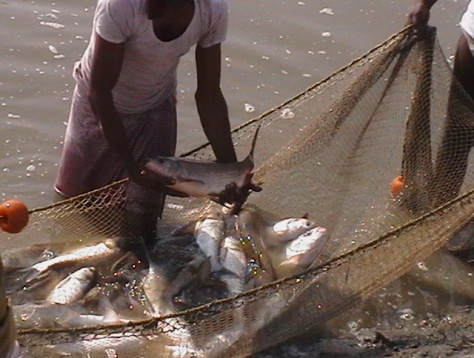

|
|
Development of package of improved breeding practices for different cultivable and endangered fishes for diversification of aquaculture
Breeding trials for the seed production of Clarias batrachus (Indian Magur), Tor putitora (Golden mahseer) and Labeo gonius (Kursa) were made successfully. The quality seed production of magur was done by injecting the brooders with a dose of ovaprim (2.0 to 2.5 ml/ kg fish). The stripping of golden mahseer collected from Lakes Bhimtal, Naukuchiatal and Sattal was done for collecting the eggs and sperms and carrying out fertilization trials. The fertilized eggs were kept in mahseer hatcheries at Bhimtal and Pantnagar and better hatching result (65- 85%) was obtained in flow through system at Pantnagar. The seed production of Labeo gonius was also done at Pantnagar during rainy season.
The produced seeds of these fishes were reared separately in nursery and rearing ponds phase wise at different stocking densities providing different environmental conditions. There was better survival and growth of the fish fry provided with 20-25 nos. Brachionus / post-larvae daily at the stocking density of 600 post-larvae/ m2. The rearing results of fry at stocking density of 50 fry/ m2 was found better when these were fed with a mixture of soybean oil cake (30%), mustard oil cake (30%), rice bran (39%) and brotone (1%). |
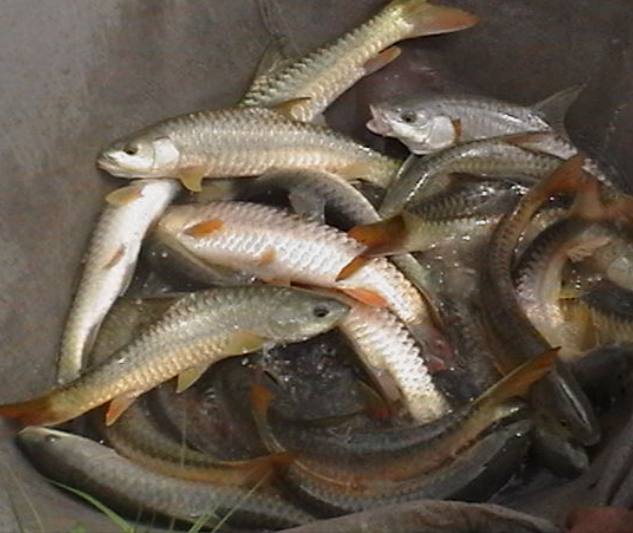
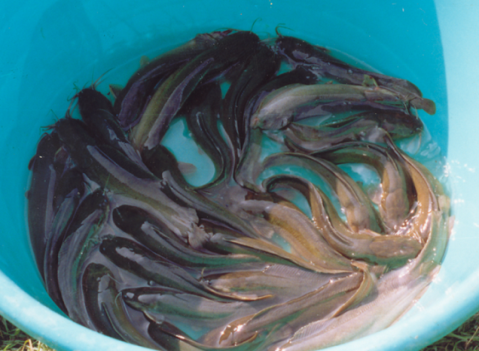
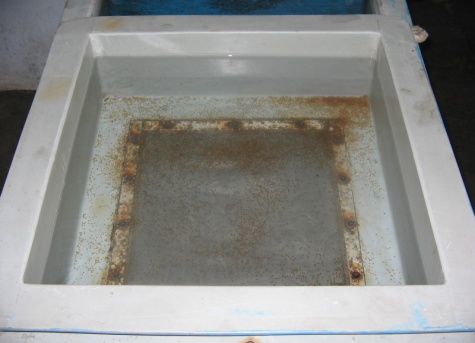
|
|
Farming feasibility and conservation of golden mahseer (Tor putitora)
The population of golden mahseer in different streams has been estimated. The breeding grounds of mahseer have been identified and the factors causing the decline of mahseer have also been identified. Restoration programme included the collection of fry and juveniles of golden mahseer from the natural sources, their rearing up to fingerling stage in pond conditions at the Instructional Fish Farm (IFF) in the foot hills region for stocking into the potential mahseer streams and lakes. The rejuvenation of golden mahseer has greatly helped in boosting its production in lakes and improving the tourism in the hill state. |
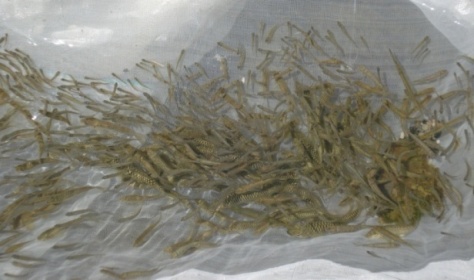
|
|
Integrated fish farming technology
The duck-cum-fish culture technology has been developed for Tarai region of Uttarakhand in which by rearing Khaki campbell ducks @ 300- 400 nos/ ha in the system, a production of 6000 kg fish/ha/yr/ and 270 eggs/duck/yr was obtained without any addition of manure in the pond. |

|
|
Biomanipulation of lakes Nainital and Naukuchiatal for ecosystem restoration
After application of biomanipulation and aeration technologies, partial removal of unwanted fishes, stocking of eco friendly fishes in standard ratio and establishing aeration discs in bottom in the Lakes Nainital and Naukuchiatal, the nutrients concentration (nitrate, phosphate etc.) have started to decrease and the anaerobic hypolimnion now contained sufficient amount of oxygen, the water clarity and population of phytoplankton, zooplankton and benthic organisms has increased which are elements of a balanced ecosystem. Al so mass mortality of fishes which was common during mixing period, is now totally stopped and fishes are growing well. |
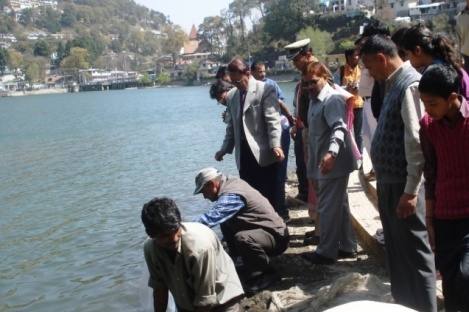
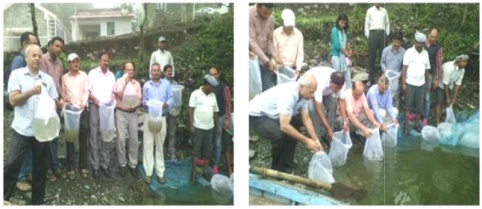
|
|
Technology of seed production of murrels
Natural breeding and larval rearing technologies for two murrel species Channa puctatus and C. striatus under pond conditions have been standardized with feasibility assessment for adoption by fish farmers. |
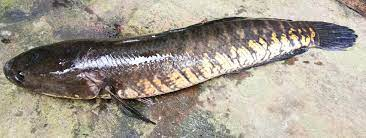
|
|
Introduction and seed production of genetically improved stock of fishes
Genetically superior stocks of Amur carp and Jayanti rohu have been added to the farm during along with existing cultivable species for the quality improvement. Amur carp seed having 20-29 % more growth potential, was procured from Fisheries Research and Information Centre, Bangalore while Jayanti Rohu seed was obtained from CIFA, Bhubaneshwar. At present more than two crore spawn of these fishes are produced and about 25 lakh fish seeds have been distributed to fish farmers of different states viz. Uttar Prodesh, Uttarakhand, Rajasthan, Haryana, Himachal Pradesh, Bihar etc. and to the farmers of the neighbor country Nepal. |
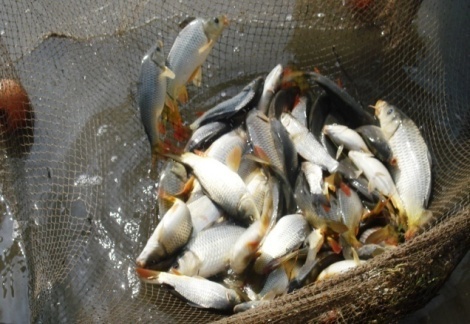
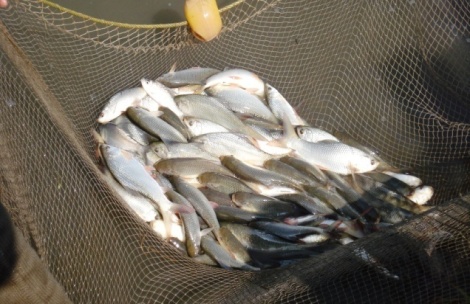
|
|
Freshwater prawn culture in Tarai region of Uttarakhand
Monoculture of giant freshwater prawn, Macrobrachium rosenbergii has been standardized and a production of 1183.20 kg/ha/6 months was achieved. Incorporation of the same in composite culture was also done. Though survival was not up to mark but growth was satisfactory. |
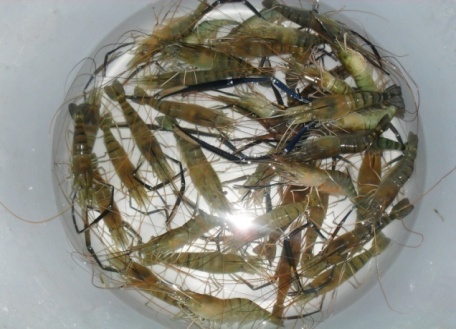
|
|
Mycofiltration for water quality improvement and better fish growth
The study done on the application of mycofiltration with variable water filtration rates conclude that mycofiltration technique is an excellent technique for filtering water, improving its quality and providing stable environment for better fish growth. This technique can be used for growing fish in water filtered through mycofiltration as it absorb heavy metals, microorganisms and enhance the productivity of water. This technique makes the suitable condition of the hydrographical parameters and does never cause any stress in the environment as well as growth of the fishes. This can also be said that it is an integrated technique with mushroom cum fish culture and is easy to be handled and very much cost effective. |
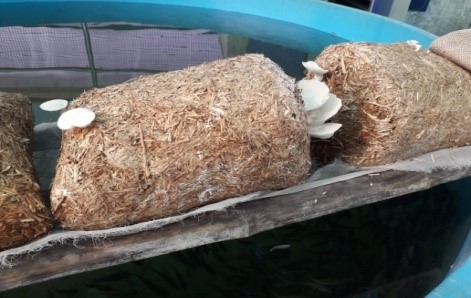
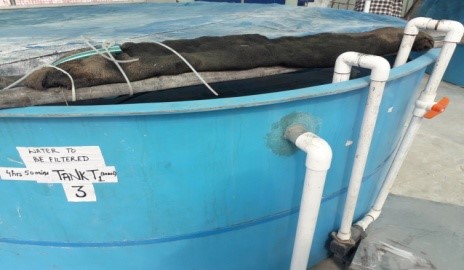 |
|
Biofloc technology for fish production
The biofloc technique with variable carbon source is an excellent technique for growing fish at low input cost. This technique has been standardized for growing fish in pond polyculture system at very high stocking density by maintaining proper aeration and C: N ratio using different carbon sources viz. molasses, potato, wheat flour, yam, sorghum etc. and enhance the productivity of water. In this system, most of the fishes performed better from weight gain and specific growth point of view in the unit where wheat flour was used as carbon source. This technique makes the suitable condition of the hydrographical parameters and does never cause any stress in the environment as well as growth of the fishes. |

 |
|
Use of herbal extracts for immune- stimulatory responses
Different herbal extracts viz. Aswagandha, Safed musli, Giloy, Aloevera etc. are commonly utilized in Ayurvedic and Unani medicines. These plants have a lot of potential as a versatile therapeutic agent. Use of these products at very low level along with fish feed shows better immune stimulatory response and gives better fish growth result. |
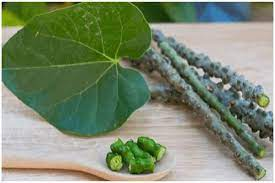 |
|
Seed production of ornamental fishes
Standardized the breeding and seed production protocol of Sword tail and Guppy ornamental fishes first time in Tarai region of Uttarakhand. The broodstock rearing was done properly on quality fish feed encompassing rice, wheat, soybean and groundnut cake. The best performance of spawning was obtained at 24 oC water temperature using one male and three female while best result of hatching was obtained at 28 oC. This technology has also been adopted by many farmers. |
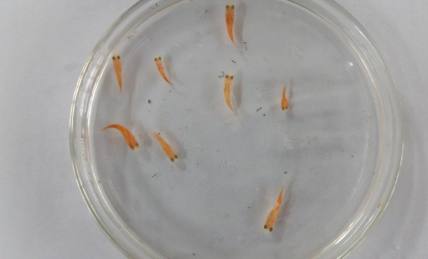
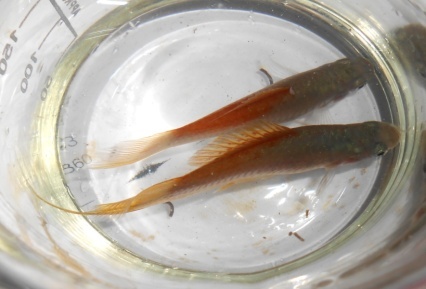 |




















